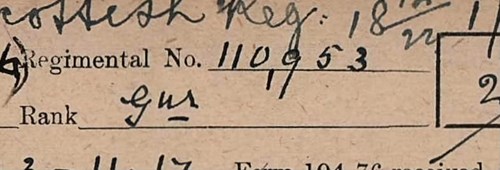Further Hints and Tips to assist with finding Pension Records
- Home
- World War I Articles
- Further Hints and Tips to assist with finding Pension Records
The following may assist WFA members in the search for pension records
1) If using a regimental number as one of the search criteria, and there are no 'hits' try inserting commas: For instance instead of 110953 try 110,953. This may then come up. This is due to the Ministry of Pensions quite often inserting commas into the regimental numbers, which have been copied 'exactly as seen' during the indexing process by Ancestry.

2) Many common Christian names were abbreviated by the Ministry of Pensions. These abbreviations have not been 'interpreted' by Ancestry (doing so may have meant misinterpretation). A very common example of this is 'William'. If you are looking for a William Smith (there are lots), but can't find him, try 'Wm' instead of 'William'.
3) There is also the ability to use 'wild cards'. The 'wild card' option (inserting an asterisk) helps to open up searches in case of uncertainty about spelling. For example H*rrick brings up Herrick and Harrick, and Tatters* brings up Tattersfield, Tattersall, Tattershall, Tatternall.
4) Take care with men who have apostrophes in their name. O'Connor may have an apostrophe, may have a gap (O Connor) or be one word (Oconnor).
5) The regimental filter can be hit and miss. This is due to wild variations in the noting of the regiment by the Ministry of Pensions. This is covered in the downloadable document available on the 'log-in' page.
6) There are a number of cards and ledgers which have had the 'front' of the document separated (digitally) from the reverse. Sometimes a search may bring up the (blank) reverse and a user may wonder 'where is the front of this record?'. There are two easy methods which can be used to locate the 'divorced' reverse (or front) of the record. To locate this divorced side in the first instance go to the 'filmstrip' icon.

Click on this. The 'divorced' page may then be be immediately apparent when the 'row' of records appear. This is an example of this happening: Frank Mason 3/8677. Clicking on the 'film strip' shows the 'divorced' page immediately adjacent to the located record. If it is not adjacent, please re-input the search and look for alternative 'hits'.
If the above does not work, it is quite often the case that the 'divorced' side of the record has been tagged under a second soldier when this second soldier is named on the front of the record. For instance, we have William and Edward Owen. William (tagged as Wm) is numbered 30214 in the South Wales Borderers (S W B is the tag on Fold3). His record is easily findable. Also on his ledger is his brother Edward (14858 R W F). If you were just to search for Edward all you would locate would be the reverse of the ledger. On both of these records, there is two tagged 'relatives in common' Catherine and Mary, so searching under these names would bring up both the front (or reverse) of the ledger.
Clearly locating the 'other part' to the record in this instance takes some work, but so far in all cases this has been successful, given a couple of minutes manipulation of the search engine. This only is a problem in a very small number of cases, but has been flagged with Ancestry / Fold3 and they are undertaking some work to resolve this so that the 'divorced' records are reunited.
If members would like to share any useful hints and tips, please do get in touch with me and I will look to share these in future updated. I can be contacted via the following email address: pensionrecords@westernfrontassociation.com
David Tattersfield, Vice-Chairman, The Western Front Association





